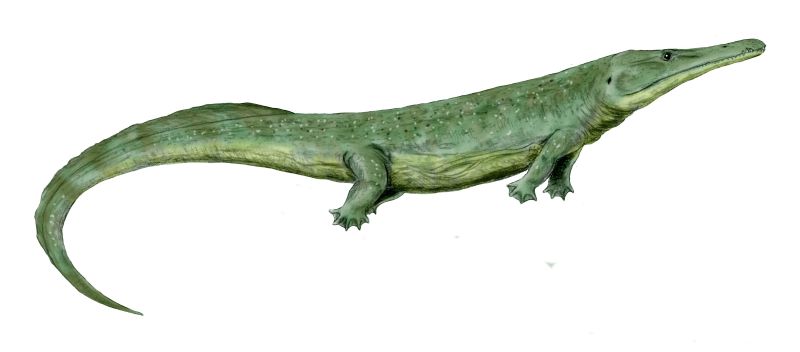- Prionosuchus
Taxobox
name = Prionosuchus

image_caption = "Prionosuchus plummeri"
image_width = 240px
fossil_range =Late Permian
regnum =Animal ia
phylum = Chordata
superclassis =Tetrapoda
classis =Amphibia
ordo =Temnospondyli
familia =Archegosauridae
genus = Prionosuchus
genus_authority = L. I. Price, 1948
subdivision_ranks = Species
subdivision ="Prionosuchus plummeri""Prionosuchus" is a genus of extremely large
Temnospondyli amphibian from the LatePermian (270 million years ago) which was found in an area of what is nowBrazil .Description
The fragmentary remains of this animal have been found in the
Pedra do Fogo Formation in theParnaiba Basin of Northeastern Brazil, and it was described by L.I. Price in 1948. [L.I. Price, 1948, Um anfibio Labirinthodonte da formacao Pedra de Fogo, Estado do Maranhao: Ministerio da Agricultura, Departamento Nacional da Producao ineral Divisao de Geologia e Mineralogia, Boletim n. 124, p. 7-32.] Reaching an estimated length of 9 m (30 ft), "Prionosuchus" is the largest amphibian ever found.With an elongated and tapered snout, numerous sharp teeth, long body, short legs, and a tail adapted for swimming, its general appearance was very similar to a modern crocodile and it probably had a similar lifestyle as an ambush aquatic predator feeding on fish and other aquatic animals.Classification
It has been classified as an
archegosaurian by Carroll. [R. L. Carroll, 1988,Vertebrate Paleontology and Evolution. W.H. Freeman and Company ] The genus ismonotypic with "P. plummeri" being the only species described. The archegosaurs were a group oftemnospondyli that occupied the ecological niche of crocodiles andalligator s during the Permian, and of which the European genus "Archegosaurus " is typical. The group went extinct at the end of the Permian and the niche was subsequently filled by reptiles such as thephytosaur s in theTriassic period.Cox and Hutchinson re-evaluated "Prionosuchus" in 1991 and synonymized it with the genus "
Platyoposaurus " from Russia. On the basis of this study, the Pedra do Fogo Formation was reevaluated to be of Middle to Late Permian age. [Cox, C. B. and Hutchinson, P., 1991. Fishes and amphibians from the Late Permian Pedrado Fogo Formation of northern Brazil.Palaeontology, 34: 561-573] However, "Platyoposaurus" was comparatively smaller, reaching a total length of only 2.5 meters (8.2 ft), indicating that the two animals are distinct at least at the species level. Alternative studies based on plants and pollens indicate that this formation is rather of Early Permian age, making "Prionosuchus" not to be contemporary with "Platyoposaurus". [Mussa D & Coimbra AM., 1987, Novas perspectivas de comparação entre as tafofloras permianas (de lenhos) das Bacias do Parnaíba e do Paraná. X Congresso brasileiro de Paleontologia. Rio de Janeiro. Anais da Academia Brasileira de Ciencias, 2: 901-922.] [Caldas EB, Mussa D, Lima Filho FP & Roesler O., 1989, Nota sobre a ocorrência de uma floresta petrificada de idade permiana em Teresina, Piauí. Bol IG-USP, Publ Esp 7: 69-87.] Most paleontologists consider "Prionosuchus" as a valid genus.Paleoecology
"Prionosuchus" lived in a humid and tropical environment as indicated by the petrified forest of the Pedra do Fogo formation in which the fossil has been found. The strata composed of
siltstone s,shale s andlimestone s were deposited inlagoon al and fluvial environments. [Schobbenhaus, C., Campos, D. A., Derze, G. R., and Asmus, H. E., 1984, Geologia do Brasil: Brasõlia, D.N.P.M., Brasília, 501 pp.] Other animals discovered in the same rocks include fish (primitiveshark s,palaeoniscid s, andlungfish es) and amphibians.References
Wikimedia Foundation. 2010.
